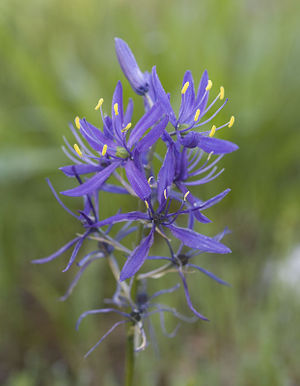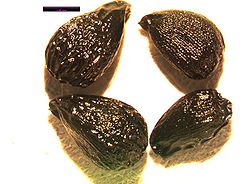Camassia quamash
- Scientific Name: Camassia quamash
- Family: Asparagaceae
- Common Names: common camas, small camas
- Codon: CAMQUA
Contents
Taxonomy
| Scientific classification | |
|---|---|
| Kingdom: | Plantae |
| Subkingdom: | Viridiplantae |
| Phylum: | Tracheophyta |
| Subphylum: | Spermatophytina |
| Class: | Magnoliopsida |
| Order: | Asparagales |
| Family: | Asparagaceae |
| Genus: | Camassia Lindl. |
| Species: | Camassia quamash (Pursh) Greene |
Description
Scapose perennial herb growing from a bulb, up to 7 dm tall.[2] Leaves basal, linear,[3] fewer than 10, up to 60 cm long.[4] Inflorescences racemose, to 30 cm long.[2] Flowers bilaterally symmetrical; tepals 6, bluish purple, unevenly distributed with the lowest being apart from the others; stamens 6, yellow; pistil 3-carpellate with superior ovary, slender style and 3 stigmas.[5] Tepals spreading irregularly when withering, not twisting together to covary ovary.[5] Capsule 3-celled, 10-25 mm.[2]
Bloom Period
April- June[2]
Distribution
British Columbia south to California, east to the Rocky Mountains.[2]
Habitat
Open, moist areas, often where dry by late spring, at low to mid-elevations in the mountains.
Mesic to vernally moist meadows and grasslands in the lowland, steppe and montane zones ([6]). Soil Texture Fine, medium or coarse soils Nutrients Nitrogen rich soils. Soil Reaction / Salinity 5.7-7.0 – no salinity tolerance, low CaCO3 tolerance pH 5.1 to 7.8 ([7]). Moisture Regime High moisture use – no drought tolerance Shade Tolerance Shade-intolerant ([8]). Successional Status In grasslands and meadows, it is most prevalent in initial and early seral communities, but also occurs in later seres.
Seral species on moist sites. Fire climax on drier sites ([9]).
Uses
Site Rehabilitation-Useful for prairie restoration ([10]).
Wildlife-Livestock, deer, elk, moose, and caribou graze common camas and pigs consume the bulbs.A good bee plant ([11]). Ungulates eat Camassia and gophers may even transport bulbs into new areas ([12]).
Landscaping-Common camas is planted as an ornamentalUse in meadows, grassy slopes and banks. Showy bloom with attractive seed heads. Excellent in borders, mixed borders and bulb beds. Very tough plant for exposed, hot dry sites once established ([13]).
First Nations-Common camas bulbs were eaten by western Indians, trappers, and early settlers. Many western Indian tribes also used the bulbs as a trade item. Staple root crop pre-European contact. Prolonged pit cooking converts the high levels of inulin inherent in Camassia to digestible sugars. Hence, Camassia was a sweetener as well as an important trade item. The gathering of Camassia illustrates local systems of land management: family plots were well tended throughout generations and kept clear of weeds and rocks, actively maintained by hand and controlled burns for long-term harvest ([14]). Cakes have been formed, cooked and dried for storage and trade ([15]).
Other-Common camas was planted for mountain grassland restoration in western Washington, using bulbs salvaged from a nearby area undergoing subdivision. Plants can also be established by fall planting of seed. Strongly associated with Coastal Douglas-fir [16] Zone and its dry sub-zone characterized by the presence of Quercus garryana ([17]). Bulb - raw or cooked. The bulb, which can be up to 5cm in diameter, has a mild, starchy flavor when eaten raw, but a gummy texture that reduces the enjoyment of it somewhat. When cooked, however, it develops a delicious sweet flavor somewhat like sweet chestnuts, and is a highly nutritious food. Excellent when slow baked, it can also be dried and made into a powder which can be used as a thickener in stews or mixed with cereal flours when making bread, cakes, etc. The bulbs can be boiled down to make a molasses, this was used on festival occasions by various Indian tribes. The bulbs can be harvested at any time of the year, but are probably best in early summer when the seeds are ripe. One report says that the bulbs contain inulin (a starch that cannot be digested by humans) but that this breaks down when the bulb is cooked slowly to form the sugar fructose which is sweet and easily digested. Quamash bulbs were a staple food of the N. American Indians. The tribes would move to the Quamash fields in the early autumn and, whilst some people harvested the bulbs, others would dig a pit, line it with boulders then fill it with wood and set fire to it. The fire would heat the boulders and the harvested bulbs would then be placed in the pit and the whole thing covered with earth and the bulbs left to cook slowly for 2 days. The pit would then be opened and the Indians would feast on the bulbs until they could no longer fit any more in their stomachs. Whatever was left would be dried and stored for winter use.[18]
Propagation
Propagate from offsets or seed. Sow seed in a sealable container and refrigerate for 3 months or until germination starts. Germination is often poor. Seedlings take 3-4 years to flower.
Fruit and Seed Collection and Extraction Allow seedheads to dry on plant, then remove and collect ([19]). Common camas seeds can be collected as soon as the pods mature (turn light brown) or split open to reveal the mature black seeds. Pods ripen from late May-July depending on latitude, longitude, moisture conditions, or elevation ([20]).
| FloweringTime | April - June |
| Fruit Ripening Time | May - Aug |
| Crop Intervals | Perennial |
| No. of seeds per pound | 117014 |
Seed Storage Dry seeds can be dried and stored at 3-5º C for 2 to 5 years ([21]).
Fruit/Seed Dormancy and Treatment For maximum germination, seeds should have 42 -100 days of cold, moist stratification at 1-5º C ([22]). Alternatively seed can be sown in trays or pots in the fall and allowed to break dormancy naturally ([23]). After fall sowing, one-leafed, grass-like seedlings will emerge in February or March under suitable conditions. Seedlings require moisture through the spring growing period to survive. Warm temperatures during seedling development can be lethal (USDA). Seeds can also be sprinkled on top of soil in flats lined with pea gravel. The flats should be a minimum of 15 cm deep and should then be kept in a semi-shaded location for many years. This will form a sod or turf which can be cut up and placed in gardens, meadow planting or landscaping ([24]).
Cold stratification required.
Seed
Seed sample from: 2011
Average Measurement: 2.8 x 1.8 x 1.8
Measurement Range: L: 2.5 - 3.3, W: 1.5 - 2, D: 1.5 - 2.25
Features
Shape: Narrow at hilum end, broadening out to a more rounded opposite end. CAQU slightly smaller than CALEI.
Color: Seeds black. Hilum more conspicuously contrasting seed color in CALEI than CAQU.
Surface: Seeds frequently pitted, glossy, and heavily wrinkled. CAQU tends to be more lustrous than CALEI. Seeds have a ridge that runs from hilum to opposite end.
Could be confused with: Camassia leichtlinii or Brodiaea coronaria
Latitudinal Cross Section: elliptical ![]()
Longitudinal Cross Section: obovate ![]()
Seed Storage Dry seeds can be dried and stored at 3-5º C for 2 to 5 years ([25]).
Basic Explanations and Assumptions:
The dimensions for the seeds are length x width x depth. The location of the hilum is used as the base of the seed, and the length is measured from hilum to the opposite apex. Where a style is present, the length is measured from the hilum to the bottom of the style. Width is measured at a right angle to the length at the widest part. Depth is measured at a right angle to the intersection of height and width lines.
Measurements included are the mean average for each measurement of ten separate seeds.
All measurements in millimeters unless otherwise noted.
Photo Gallery
References
- ↑ Integrated Taxonomic Information System. Retrieved from https://www.itis.gov/servlet/SingleRpt/SingleRpt?search_topic=TSN&search_value=42883
- ↑ 2.0 2.1 2.2 2.3 2.4 WTU Herbarium, Burke Museum, & University of Washington. Retrieved from https://biology.burke.washington.edu/herbarium/imagecollection/taxon.php?Taxon=Camassia%20quamash
- ↑ Native Plants of North America. Retrieved from https://www.wildflower.org/plants/result.php?id_plant=caqu2
- ↑ Flora of North America. Retrieved from http://dev.floranorthamerica.org/Camassia_quamash
- ↑ 5.0 5.1 Hitchcock, C. L., Cronquist, A., Giblin, D., & Legler, B. et al. (2018). Flora of the Pacific Northwest: an illustrated manual. Seattle: University of Washington Press. p. 705.
- ↑ Douglas et al., 2001
- ↑ Dave’s Garden, 2006
- ↑ Klinka et al., 1989
- ↑ USDA, 2006
- ↑ USDA, 2006
- ↑ PFF, 2006
- ↑ Beckwith, 2004
- ↑ S. Bastin, personal communication
- ↑ Turner, 1995
- ↑ Pojar & MacKinnon, 1994
- ↑ (CDF)
- ↑ BCMOF, 1999
- ↑ Useful Temperate Plants. Retrieved from http://temperate.theferns.info/plant/Camassia+quamash
- ↑ Dave’s Garden, 2006
- ↑ USDA
- ↑ USDA, 2006
- ↑ Beckwith, 2004
- ↑ Wick and Evans
- ↑ Pettinger and Costanzo, 1981
- ↑ USDA, 2006






